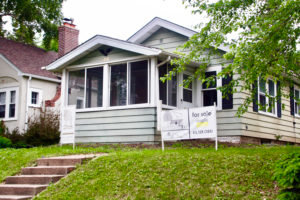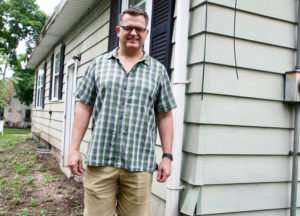By STEPHANIE FOX
The little house, sitting midblock on 13th Ave. in the Hale neighborhood, had seen better days. Built in 1924, it had been the home for families who came and went, but when the last owner lost her husband, she began to collect items—lots of items. When she finally sold it last summer, junk and all, it became the beginning of architect Eric Hanson’s plan to save older homes by remaking them for modern families.
Hanson had watched as dozens of urban homes were sold and then torn down, with huge mansion-like houses replacing them. The new houses are, he insists, often too big for the lots on which they sit and too big for their neighborhoods, dwarfing nearby homes. “Teardowns are happening like there is no tomorrow,” he says. “I am trying to save houses instead, remodeling them to fit into the neighborhood.”
 Photo right: The little house on 13th Ave. is still in the ‘before’ stage of remodeling. (Photo by Stephanie Fox)
Photo right: The little house on 13th Ave. is still in the ‘before’ stage of remodeling. (Photo by Stephanie Fox)
He searched neighborhoods from South Minneapolis to the Wisconsin border until he came upon a one-story 867-square-foot home, on a tiny .12-acre lot, a block from Minnehaha Creek. And, he says, he immediately saw the possibilities. Partnered with former client Steve Aldrich, the two acquired the house last summer for $165,000 and started to plan.
The house, Hansen says, was filled with enough stuff for him to recognize it as a hoarder house.
“It was kind of sad,” he says. “After the owner’s husband died, she just couldn’t throw stuff away. We bought it ‘as is.’ There were a lot of dumpsters filled with things and a lot of trips to Value Village.” After donating the furniture, books, and antiques to a charity, he began the rehab, starting by tearing apart the interior.
Hansen has an abundance of ideas for the tiny home. He wants to move upward by adding a second story, making the 2-bedroom home into a 4-bedroom home. He wants to move the front door to create the main entrance off a patio on the side of the house, to refigure the layout and maybe, finish the basement. The house may end up with 2,500 square feet, but the footprint of the house won’t change, he says. Hansen blanches at huge homes on little lots and, he hopes, this home will be an example for others who want to live in South Minneapolis and elsewhere in the Twin Cities but want a larger home.
 Photo left: Architect Eric Hanson has big plans for the little house and for the future of smaller older homes in the Twin Cities. (Photo by Stephanie Fox)
Photo left: Architect Eric Hanson has big plans for the little house and for the future of smaller older homes in the Twin Cities. (Photo by Stephanie Fox)
JK Carpentry, who has worked with Hansen on some other projects, has signed on. “We’re taking the existing house and reviving the foundation,” says builder Jeremiah Kunde. “We’ll make it a family home. We’re trying to save stuff that might otherwise go into a landfill, and with this house, we can reutilize material and turn it back into the home. We can make it so the house will still be here 100 years from now.”
“The basement is a big room, rehabbed in the 1960s,” Hansen says. “We’ll find a way to raise the low ceiling, add drain tile it so it will be a nice dry house, maybe make it into one big family room and add colored concrete floors.”
The kitchen, he says, will have southern rooflines and lots of sunlight. ‘We have this house set up for full solar,” he says.
The plan also includes keeping the two-car garage but allowing the possibility of expanding it upward.
Projects like this, Hanson says, can take months but he hopes to sell it in the fall. But he says, what would be ideal would be a homebuyer who bought the home this summer and became part of the planning process. The home is currently on the market, even as the work on it continues.
Steve Aldrich, Hanson’s business partner in this project, claims he has only a small role in the project, besides buying the home. But, he is putting in hands-on work on the rehab. “I cut a lot of the little trees and hauled out a lot of garbage,” he says. “I’ve been mowing the lawn there.”
“Eric did work on my house in St. Louis Park about five years ago, and we talked about buying something like this and making it into something beautiful. The whole idea is to have a buyer to who understands our vision,” he says.
He says that rehabbing existing small homes is the future of residential neighborhoods in the Cities. “My first house in 1987 was only four blocks away. I love that neighborhood, near the Creek,” Aldrich says. “In 10 or 15 years, the streets around here will be filled with houses that have been rebuilt. “Everyone wants to live in nice houses while being closer to the center of the city.”
Hansen says that it would take a special kind of person to sign on now. “A lot of people don’t have the stomach for the remodeling process,” he says. “But, we are trying to engage the public.”
“Remodeling is harder than doing it from scratch,” he concludes. “But we are trying to do something different. It’s going to be beautiful.”
Comments
No comments on this item Please log in to comment by clicking here